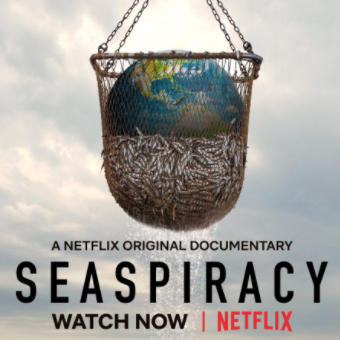By Amelia Melo, Y11
Directed by Ali Tabrizi and produced by Kip Andersen, Netflix’s Seaspiracy documentary (released on the 24th of March this year) aims to educate viewers, as well as raise awareness on the cruelties and monstrosities that are currently taking place in the global commercial fishing industry. The documentary has caused quite a commotion and generated many discussions, reviews, and ratings as it leaped into Netflix’s “Top 10 Movies” and currently rests at 8th place. However, online social media platforms show a wide array of opinions about exactly how the documentary portrayed and described the fishing industry. Whilst others are describing it as a wake up call about the true causes of marine destruction, others accuse the documentary of lying, misrepresenting the fishing industry as a whole, and oversimplifying an extremely intricate and complicated issue.
Whilst Seaspiracy may be out of bounds with their claims and proposed solutions, it did indeed succeed at shedding light on a grave problem harming our earth right now: overfishing. Overfishing is where more fish are caught than the oceans can replace by natural reproduction. Let’s take a look into the dangers and disastrous effects that overfishing has on our world.
Currently, overfishing has impacted over 85% of the world’s fish resources, and most fisheries are beyond their sustainable capacity. One of the dangerous side effects of overfishing is the elimination of essential predators. As we all learned in middle school biology class when studying ecosystems, when one member of the food chain is affected, the rest becomes completely unbalanced. Over one hundred million sharks are killed every year, which is roughly 2 to 3 every second. If shark depletion continues at this rate, an imbalance in the biodiversity of our oceans will become more and more prevalent and the food chain balance will continue to drastically unravel. Similarly, 2.7 trillion fish are extracted from oceans yearly, which is an impossible barrier for fish populations to naturally balance.
Illegal fishing is also a huge problem, with roughly 20% of all fish being caught coming from illegal fisheries.
In addition, according to Seaspiracy, overfishing breeds slavery and human trafficking aboard illegal fishing ships in Thailand.
Another side-effect that is brought about by overfishing is by-catch, otherwise known as the unwanted fish caught. Huge fishing nets do not discriminate in terms of marine animals, and usually trap everything in their path, instead of singling out the necessary targeted species. So, the unwanted sea animals tend to be thrown overboard already dead or injured.
Furthermore, micro-organisms in the sea are crucial for greenhouse gas absorption, and must not be overfished. As accurately stated in Seaspiracy, micro-organisms, such as plankton and krill, absorb four times as much carbon dioxide as the Amazon rainforest. So to tamper with their populations and habitats would impair carbon dioxide levels in our atmosphere (by causing them to increase); don’t forget that oceans provide 50% of the world’s oxygen.
Lastly, according to environmentalist George Monbiot who participated in the film, when referencing the Great Pacific Garbage Patch: “46% of it is discarded fishing nets, which are far more dangerous for marine life than our plastic straws.” This valid statistic was used in comparison to that of plastic straws, which claims that they pollute only 0.03% of the world’s ocean, in comparison to roughly 20% from fishing gear. Tabrizi put this into context by saying that it would be “like trying to save the Amazon rainforest and stop logging by boycotting toothpicks.” Professor Denise Hardy, who’s study was referenced in the documentary, backed this claim up by insisting that “abandoned, lost, derelict fishing gear poses substantial environmental harm to coastal and marine species.”
However, whilst Seaspiracy did accurately highlight the bigger problem, it was viciously attacked and critiqued for its inaccuracy and false claims. One marine biologist states that “Many of the statements made were based on outdated and sometimes redacted studies, while other issues were grossly exaggerated and links were often made where they don’t exist.” Let’s take a look into the biggest false claims that were issued in this controversial documentary:
- Oceans will be virtually empty by 2048. This statement, once dissected by the media, was proven to be unreliable. The data stemmed from a 2006 study, in which the author of the study is unsure whether the data should be applied to future scenarios. According to a professor at Dalhousie University, “The 2006 paper is now 15 years old and most of the data in it is almost 20 years old.” […] “Since then, we have seen increasing efforts in many regions to rebuild depleted fish populations.” A fisheries expert, Michael Malnychuk, also rebutted the claim by stating that this prediction of empty oceans in 2048 is an “unrealistic extrapolation way beyond the bounds of available data.”
- There is no such thing as sustainable fishing. This point was heavily refuted by several figures. The Marine Stewardship Council issued a statement saying “One of the amazing things about our oceans is that fish stocks can recover and replenish if they are managed carefully for the long-term.” Also, per D. Bryce Stewart (a marine ecologist and fisheries biologist) “in the most recent assessment by the United Nations Food and Agriculture Organisation it was calculated that almost two-thirds of fish stocks were being harvested sustainably (65.8 percent) and that 78.7 percent of all landings of marine fisheries come from biologically sustainable stocks.” It is therefore ignorant, pessimistic, and unmotivating to extract a general conclusion like “there is no such thing as sustainable fishing.”
- Interviews were taken entirely out of context. Many organizations and individuals that were interviewed for Seaspiracy have issued press releases arguing that their responses were completely blown out of proportion. The Plastic Pollution Coalition urges that “when we answered the questions, they bullied our staff and cherry-picked seconds of our comments to support their own narrative.” Also, participant Mark J. Palmer of the Earth Island Institute complained that “The film took my statement out of context to suggest that there is no oversight and we don’t know whether dolphins are being killed. This is simply not true,” in response to a clip of Palmer talking about dolphin safety.
- The solution is for everybody to simply stop consuming fish. Seaspiracy encourages every single viewer to simply abstain from eating fish ever again, as a solution to overfishing, which is simply not the case. Critics slammed Seaspiracy in arguing that this was an oversimplification of a much more tricky situation. Stewart proves why this would be impossible and ineffective by saying that “over 3 billion people get 20 percent of their protein from aquatic food. Plus over 60 million people are directly employed in fisheries and aquaculture.” Also, In many African and South Asian coastal nations, fish may account for as much as 50 percent of protein in a typical diet. Hence, boycotting all consumption of fish is simply not the answer. This argument can be applied for similar solutions as well. For example, the answer to over-consumption of meat isn’t for everybody on the earth to go vegan right at this instant.
To summarise, was Seaspiracy accurate in calling to our attention the fact that overfishing is a huge, menacing threat to marine life and our planet as a whole? Yes. However, was it also a documentary that took studies, interviews, and claims way out of context, made preposterous linkages, and over-extrapolated using faulty bases of evidence? Yes. Should individuals wish to see it, I heavily suggest it is interpreted with a pinch (or two) of salt, and this documentary serves as a reminder to always check for accuracy in all forms of media and expression.
Here are 3 movies that were recommended as more reliable alternative to Seaspiracy which cover the exact same issue and themes:
- 2009 Film End of the Line
- 2015 Racing Extinction
- 2017 Chasing Coral



